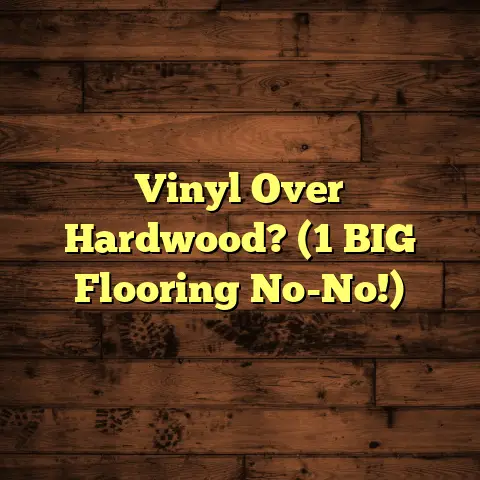Plywood as Finished Flooring? (9 Big Problems!)
I’ve been getting a lot of questions about using plywood as finished flooring.
It’s trendy, affordable, and has that raw, industrial look that some folks love.
But is it really a good idea? Let’s dive into the nitty-gritty.
Plywood as a finished floor has definitely gained traction.
Traditionally relegated to subflooring, plywood is now popping up in homes and businesses, touted for its cost-effectiveness and unique aesthetic.
But before you rip up your existing floors and slap down some plywood, let’s talk about what you need to know.
I’m going to break down nine big problems I see with using plywood as your final floor covering.
Trust me, you’ll want to consider these before making a decision.
Expert Picks: What the Pros Say
Before we get into the problems, what do the experts think?
I’ve consulted with several interior designers and fellow contractors to get their take.
1. Durability:
Most experts agree that plywood, on its own, isn’t as durable as hardwood, laminate, or tile.
- Hardwood: Can last for decades with proper care and refinishing.
- Laminate: Offers good scratch resistance and can withstand moderate traffic.
- Tile: Extremely durable and water-resistant, ideal for high-traffic areas.
- Plywood: More susceptible to scratches, dents, and moisture damage.
However, with the right finish and proper maintenance, plywood can hold its own.
2. Aesthetic Appeal:
This is where plywood shines! Many designers love the raw, natural look of plywood.
It can be stained, painted, or sealed to create a variety of looks, from rustic to modern.
The key is to embrace the imperfections and variations in the wood grain.
3. Cost-Effectiveness:
Plywood is definitely cheaper than most other flooring options.
- Plywood: Typically ranges from \$1 to \$3 per square foot.
- Hardwood: Can cost \$5 to \$15+ per square foot.
- Laminate: Generally falls between \$2 and \$8 per square foot.
- Tile: Varies widely, from \$3 to \$20+ per square foot.
However, remember to factor in the cost of finishing, sealing, and ongoing maintenance.
4. Versatility:
Experts agree that plywood can be surprisingly versatile. It works well in:
- Modern: Clean lines and minimalist design.
- Rustic: Warm, natural textures and earthy tones.
- Industrial: Exposed materials and a raw, unfinished look.
The key is to choose the right grade of plywood and the appropriate finish to match your desired style.
5. Installation:
Installation can be tricky.
Proper subfloor preparation is crucial, and you’ll need to be precise with your cuts and fasteners.
Some experts recommend hiring a professional to ensure a proper installation, especially if you’re not experienced with woodworking.
Alright, with the expert opinions covered, let’s get into the problems.
Section 1: Problem 1 – Susceptibility to Moisture
This is HUGE. Plywood and water are not friends.
Plywood is made of thin layers of wood veneer glued together.
When exposed to moisture, these layers can start to separate (delaminate), causing the floor to warp, swell, or even rot.
Imagine a rainy day, and someone tracks water inside.
With hardwood, you wipe it up, no big deal.
With plywood?
You’re racing against the clock before it soaks in.
I’ve seen it happen firsthand.
A client of mine insisted on plywood floors in their bathroom.
Despite my warnings, they went ahead.
Within a year, there was noticeable warping around the toilet and shower.
Expert Opinion:
Moisture management is critical.
Experts recommend using a high-quality sealant and regularly inspecting the floor for any signs of water damage.
Proper ventilation in bathrooms and kitchens is also essential.
Here’s a quick guide for moisture levels:
Using a moisture meter can help you monitor the moisture content of your plywood floor and take action if it gets too high.
Section 2: Problem 2 – Surface Finish Durability
Think about your existing floors.
Do they have a tough finish that protects against scratches, dents, and scuffs?
Plywood, on its own, doesn’t. It’s relatively soft and easily damaged.
I once worked on a project where the homeowner used plywood flooring in a high-traffic hallway.
Within months, the surface was covered in scratches from shoes and furniture.
Even with a protective finish, plywood is more susceptible to wear and tear than harder materials like hardwood or tile.
Expert Perspectives:
The longevity of your finish depends on the type of finish you use and the amount of traffic the floor receives.
Polyurethane finishes are generally more durable than varnish or lacquer.
However, even the best finishes will eventually wear down and need to be reapplied.
Here is a comparison table for different types of wood finishes:
Section 3: Problem 3 – Limited Lifespan
Let’s be honest, plywood isn’t a forever floor.
While a well-maintained hardwood floor can last generations, plywood has a much shorter lifespan.
I generally tell my clients to expect 10-20 years, max, with plywood flooring, depending on the quality of the plywood, the finish, and the amount of traffic.
Hardwood, on the other hand, can easily last 50-100 years or more with proper care.
Expert Assessments:
Experts agree that plywood flooring will likely need to be replaced sooner than other flooring options.
This is especially true in high-traffic areas or homes with pets or children.
Planning for replacement costs down the line is essential if you choose plywood.
Here’s a table comparing estimated lifespans:
Section 4: Problem 4 – Noise and Acoustics
Ever walked into a room with a loud echo?
That might be due to the flooring.
Plywood, unfortunately, isn’t great at absorbing sound.
It can actually amplify noise, making your home feel louder and less comfortable.
I’ve had clients complain about the “hollow” sound of plywood floors, especially in rooms with high ceilings.
Expert Insights:
To mitigate noise issues, experts recommend using rugs, carpets, or underlayment to dampen sound.
Acoustic panels on walls and ceilings can also help improve the overall sound quality of a room.
You can also use soundproof underlayment to reduce the noise.
Here is a comparison of different types of underlayment for noise reduction:
Section 5: Problem 5 – Installation Challenges
Don’t think you can just slap down some plywood and call it a day.
Installing plywood flooring requires careful preparation and precise execution.
The subfloor needs to be perfectly level and free of any imperfections.
Unevenness can cause the plywood to warp or crack over time.
I’ve seen DIY jobs where the plywood wasn’t properly secured, leading to squeaky floors and loose boards.
Expert Opinions:
Proper subfloor preparation is paramount.
Experts recommend using a self-leveling compound to create a perfectly flat surface.
Use construction adhesive in addition to screws or nails to ensure the plywood is securely fastened to the subfloor.
Here are some tools you would need for proper plywood flooring installation:
- Measuring Tape
- Circular Saw
- Jigsaw
- Sander
- Level
- Construction Adhesive
- Screws/Nails
- Safety Glasses
- Dust Mask
Section 6: Problem 6 – Limited Resale Value
Thinking of selling your home down the road?
Plywood flooring might not be the best selling point.
While some buyers might appreciate the unique look, many will see it as a cost-cutting measure and a potential problem.
I’ve seen homes with plywood floors sit on the market longer than comparable homes with more traditional flooring.
Expert Commentary:
While market trends can vary, plywood flooring generally doesn’t add as much value to a home as hardwood, tile, or even high-quality laminate.
If resale value is a major concern, consider using plywood in less visible areas, such as bedrooms or home offices, and opt for more traditional flooring in high-traffic areas like the living room and kitchen.
Here is a table comparing the impact of different flooring types on resale value:
Section 7: Problem 7 – Environmental Concerns
Where does your plywood come from?
Is it sustainably sourced?
These are important questions to ask.
Plywood production can have a significant environmental impact, from deforestation to the use of harmful chemicals in the glue.
I always encourage my clients to choose eco-friendly plywood options whenever possible.
Expert Insights:
Look for plywood that is certified by the Forest Stewardship Council (FSC).
This ensures that the wood comes from responsibly managed forests.
Consider using plywood made with formaldehyde-free glue to reduce your exposure to harmful chemicals.
Here is a list of eco-friendly plywood options:
- FSC-certified plywood
- Plywood made with soy-based or other formaldehyde-free glue
- Reclaimed plywood
Section 8: Problem 8 – Aesthetic Limitations
While plywood can be stylish, it does have its limitations.
It might not be the best choice for every home style.
For example, it might look out of place in a formal dining room or a traditional living room.
I’ve seen homeowners try to force plywood into a design that just didn’t work, resulting in a mismatched and unappealing look.
Expert Opinions:
Plywood works best in modern, rustic, or industrial-style homes.
It can also be used effectively in more eclectic or bohemian spaces.
The key is to embrace the natural imperfections of the wood and to choose a finish that complements the overall design.
Here are some design styles that are compatible with plywood flooring:
- Modern
- Rustic
- Industrial
- Eclectic
- Bohemian
Section 9: Problem 9 – Maintenance Requirements
Plywood flooring requires specific maintenance to keep it looking its best.
Regular cleaning with a damp mop and a mild detergent is essential.
Avoid using harsh chemicals or abrasive cleaners, as they can damage the finish.
I always recommend my clients to reapply the finish every few years to protect the wood from wear and tear.
Expert Recommendations:
Use a pH-neutral cleaner specifically designed for wood floors.
Avoid using excessive water when cleaning, as this can damage the plywood.
Apply a coat of wax or polish every few months to protect the finish and enhance the shine.
Here is a table for a maintenance schedule for plywood flooring:
Conclusion
So, is plywood a good choice for finished flooring?
As I’ve explained, it’s not a simple yes or no.
There are definitely some challenges to consider, from moisture susceptibility to limited lifespan.
However, if you’re aware of these challenges and willing to take the necessary precautions, plywood can be a stylish and affordable flooring option.
Ultimately, the decision is yours.
Weigh the pros and cons carefully, consider your individual needs and preferences, and talk to a professional before making a final decision.
Good luck with your flooring project!





